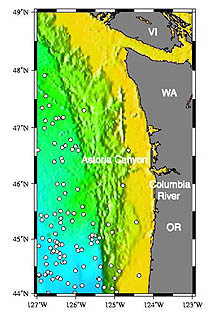
Map view of the bathymetry and earthquakes (white dots) located near Astoria Canyon and the surrounding continental margin. Click image for larger view.
Astoria Canyon: A Natural Laboratory
Bob Embley, Geophysicist
NOAA, Pacific Marine Environmental Laboratory
Off the coasts of Oregon and Washington, the eastern edge of the Juan de Fuca tectonic plate is slowly sinking beneath North America. This entire region is an incredible natural laboratory for studying the processes occurring at the edges of the Earth's tectonic plates. The spreading, slipping and collision of these plates are the cause of nearly all of Earth's major earthquakes and volcanic activity. Although the Juan de Fuca plate is one of the smaller plates, its proximity to the continent, and to several major U.S. and Canadian centers of oceanographic research, create exciting possibilities for long-term research into the processes occurring along plate boundaries.
It is surprising, then, that some major geological features within a few miles of the coast are largely unexplored. The Astoria Canyon is one such feature. Although submarine canyons are relatively common in many areas (e.g., the U.S. East Coast), they are rarer along actively subducting (sinking) regions, because the plate movements tend to disrupt their course and often prevent the formation of such long, continuous features. However, where the sediment supply is high, as it is in the Columbia River basin, submarine canyons are more likely to maintain their continuity because the powerful, sediment-laden currents tend to "keep up" with tectonic activity.
Evolution of the Canyon
On their historic 1804-05 expedition, Lewis and Clark recognized that the Columbia River was a major drainage area for western North America, and traversing it to the Pacific was a key to their success. Its importance as a long-term drainage system is probably the reason that it continues well beyond the breakers that prevented Lewis and Clark from further exploration. The Astoria Canyon has carried sediment well out into the abyssal depths for millions of years, building a large, deep-sea “fan” of mud and sand that is similar in formation to the Mississippi Delta. In recent history, the canyon has been shaped by periodic major earthquakes and the rise and fall of sea levels. The submarine landslides that occur approximately every 600 yrs provide a long-term history of these earthquakes, and the sediments now awaiting the next one offer clues as to how hard the ground actually shakes during these great events. Large earthquakes trigger sediment slides and flush large amounts of material into the head of the canyon, especially during periods of lowered sea levels.
About 17,000 yrs ago, a truly awesome event took place that may have been a major force in shaping the modern canyon. Giant floods of sediment-laden water, released by the breaching of an ice dam in Montana, roared across western Washington and into the eastern Columbia River. These floods (called the Bretz Floods after the discoverer) almost completely filled the Columbia River Gorge to heights of more than 300 meters (almost 1,000 ft). Although some of the flood dissipated in the Willamette Valley, huge amounts of sediment must have reached the mouth of the river and passed into the canyon. Such sediment-laden water probably generated powerful density currents that sped down the canyon onto the fan, eroding the canyon in its upper reaches before depositing much of its load well offshore.
The Canyon Today
As a product of a long series of geologic events, the modern canyon is an exciting prospect for exploration. It is, for example, one of the few places along the Cascadia Margin where one can observe natural exposures of the inner part of the accreted sediment wedge (formed by the Juan de Fuca plate “bulldozing” the sediments as it sinks beneath North America). The canyon has eroded partly through some of the sediment “folds” created by this process. These folds may contain large amounts of natural gas, which, when they leak out from the sea floor, create “seeps." The methane gas released from the seeps is the energy source for a chemosynthetic food chain that gives rise to unique microbes and higher life forms.
Undoubtedly, the exploration team will discover many surprises along the canyon walls and within its course. The canyon's links to the past, both historic and geologic, will make the experience all the richer.
Sign up for the Ocean Explorer E-mail Update List.






























